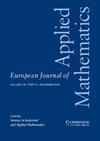各向异性平均曲率流的扩散-界面近似和弱-强唯一性
IF 1.1
4区 数学
Q1 MATHEMATICS, APPLIED
引用次数: 0
摘要
本文旨在将各向异性平均曲率流推导为各向异性 Allen-Cahn 方程的极限。我们依赖于扩散和尖锐界面模型的分布解概念,并使用相对熵方法证明了收敛性,这种方法最近被证明是界面演化问题的有力工具。利用相同的相对熵,我们证明了弱-强唯一性结果,这依赖于为各向异性能量函数构建梯度流校准。本文章由计算机程序翻译,如有差异,请以英文原文为准。
Diffuse-interface approximation and weak–strong uniqueness of anisotropic mean curvature flow
The purpose of this paper is to derive anisotropic mean curvature flow as the limit of the anisotropic Allen–Cahn equation. We rely on distributional solution concepts for both the diffuse and sharp interface models and prove convergence using relative entropy methods, which have recently proven to be a powerful tool in interface evolution problems. With the same relative entropy, we prove a weak–strong uniqueness result, which relies on the construction of gradient flow calibrations for our anisotropic energy functionals.
求助全文
通过发布文献求助,成功后即可免费获取论文全文。
去求助
来源期刊
CiteScore
4.70
自引率
0.00%
发文量
31
审稿时长
>12 weeks
期刊介绍:
Since 2008 EJAM surveys have been expanded to cover Applied and Industrial Mathematics. Coverage of the journal has been strengthened in probabilistic applications, while still focusing on those areas of applied mathematics inspired by real-world applications, and at the same time fostering the development of theoretical methods with a broad range of applicability. Survey papers contain reviews of emerging areas of mathematics, either in core areas or with relevance to users in industry and other disciplines. Research papers may be in any area of applied mathematics, with special emphasis on new mathematical ideas, relevant to modelling and analysis in modern science and technology, and the development of interesting mathematical methods of wide applicability.

 求助内容:
求助内容: 应助结果提醒方式:
应助结果提醒方式:


